THE TWENTY-FIRST CENTURY
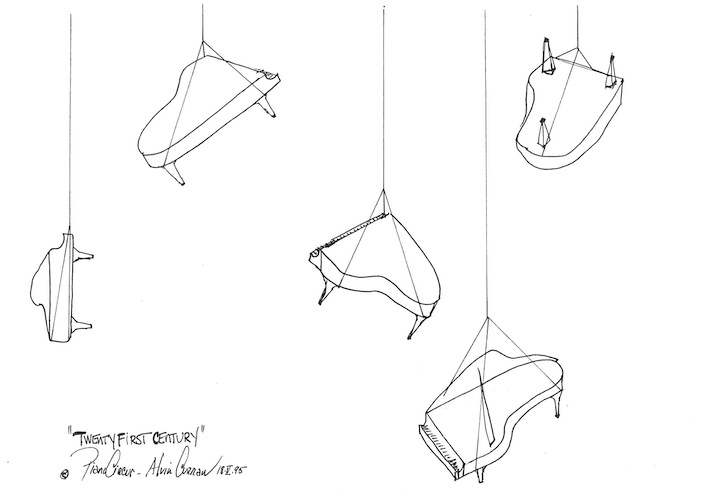
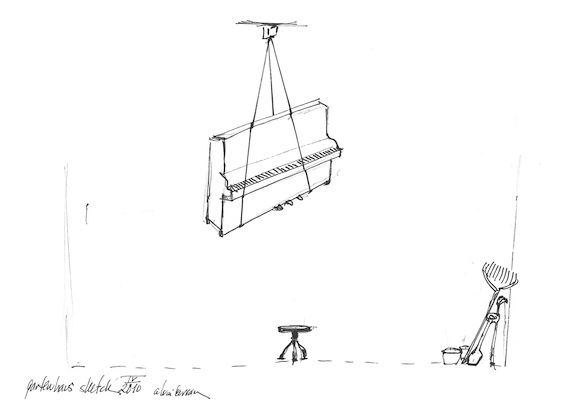


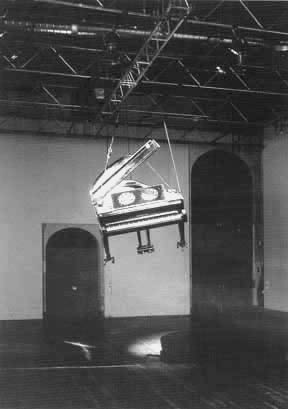
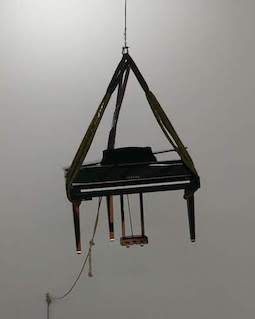

Taktlos Festival Bern 2003 (photographer unknown), Faire Avec Sete 2019 (photo Susan Levenstein) Spike Island 2022 (photo Max McClure)
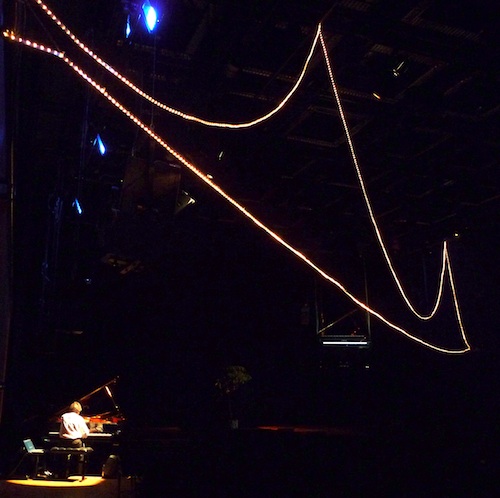
Program notes for On Hearing the Brooklyn Bridge Sing in Yiddish:
scorrevole assai, mitologicamente
A man sits at a piano (a special Diskklavier). He pauses then plays a simple A minor triad. From these familiar three tones which begin to taper off, emerges the sound of a strange chorus, sounding as if it were trying to project the same chord the man has just played; as if those notes were actual catalyzing tones which somehow produced these alien voices – in their sustained, long vocal spannings. But these tones are strange, they are “curved.” They waiver, they rise slightly, they fall slightly, they stop abruptly then begin again on a different tone trying as it were to find the initial tone they set off on, now seemingly lost and irretrievable. The man at the piano plays another tone, say G sharp 3 octaves higher – as his middle finger activates this black key the sound of human laughter from inside a cage of chimpanzees is heard along with stuttering blurts of Russolo’s Intonarumori and a wildly vibrating water faucet in the men’s room of a famous woman’s College in California – these appear as from different points in space- each sound moves to the left or the right or up or down or nowhere, each sound circles, jumps across the room, re-emerges from under your seat, from behind your back –suddenly like a rat racing across the floor, climbs the wall and reenters into one of many loudspeakers – home to rats and birds, mold, insects, industrial noise and rotting piles of abandoned sound files… This is only one imaginary beginning, but as you might have guessed - those long randomly undulating tones (speeding up and slowing down like the automobiles which produced them from the sounding metal grid below their wheels) were recordings I made in the early 80’s while standing under the Brooklyn Bridge and thinking that I was actually hearing a chorus of human-like voices of a people who have not yet been discovered - a long-lost tribe of ancient choral societies - in the sense of modern geography and anthropology. The Bridge was singing, but nobody knew what “song” or in what language, or with what kind of extraterrestrial musical intervals. Meanwhile, the pianist plays a fragment of Fats Waller’s “Ain’t Misbehavin’” in perfect stride-style. This slip on a popular banana peal activates another Diskklavier piano in another room (or the same room) – which we can only see on a video screen… an empty room – or is it an animal cage, why is there straw on the floor and bowl full of animal fodder? – there, the piano, without a piano player, is playing all by itself as if possessed by the ghosts of Conlon Nancarrow, Beethoven, Scelsi, Maryanne Amacher, or by the spells of Cecil Taylor, Merzbow or Robert Ashley. The sound of ship horns and tobacco auctioneers and Aphex Twin’s deep sighing appear in the air – suspended like a bridge – which spans a distance equivalent to that of Brooklyn to Minsk. The earlier sounds of the bridge singing are now convoluted into speaking voices, they are telling a story in Yiddish about a Rabbi who lost his way in the snow. This is convolution pure and simple, we cannot know if the bridge sings, or even speaks in Yiddish or if the the singing and speaking voices are possessed by the sonic souls of the bridge… we cannot know – and the not-knowing, as I imply here – while an enlightened form of knowing, does not allow us mortals to really know if these sounds are mere balloons of hot air, Kabbalist permutations, the sound of the Tree of Life, or a Hip-Hop BoomBox, an Allen Ginsberg Mantra, ecstatic ravings of Meister Eckhart - or the door to Dante’s 7th Bolgia. Such as these sounds envelop us – while sitting, standing, breathing sleeping, gently living and floating in this room of intergalactic audio islands (the 43 computer controlled loudspeakers suspended like a childrens toys in space) – awaiting commands from some electronic general to leap into action, leap from the bridge to the forcastle and land, zap, like a charged particle in this imaginary space-theater, “in mittn d’ menschen.
fuga a 43 voci, dal schtetl al segno poi oyber d’bricke
This performance grows out of an simple artistic process – which I have been engaged in for over 20 years when I began to develop spontaneous compositions for the Diskklavier (a midi generating pianoforte) and digital samplers. So by applying (mapping) hundreds and even thousands of sampled sounds to each key (and velocity levels) I and my fingers are, as it were, able to “play the world” not only on this magisterial black box (the grand piano) – iconic symbol of all human musical achievement, but I am able to play hundreds of worlds of sounds (sampled sound files) - while creating in the moment a unique and contradictory musical event of pure abstraction and pure representation, such is the obscure ephermeral nature of sound that speak the naked narratives of our time in all tongues with simply any audible vibration and concrete sound. This is the art of memory, of forgetting and remembering and forgetting merged into one instant - one single act of collectively sharing space and moving air. The bridge’s tissues span couple and connect, they flex and link; without them one can only dream what might lie on the other side. I cannot tell you any more without having to tell you the impossible or worse, tell you lies: about why and how I am making this spontaneous music by myself and with icons and friendly ghosts.
Two Diskklaviers will be used, one which I play and one suspended from the ceiling in the performance space under a sketch in lights of the Brooklyn Bridge, which is played by commands from the first piano.
Part of the inspiration for this work comes from the radio work of Victor Packer a Yiddish actor turned radio artist who was considered a Yiddish speaking Dadaist. and fragments of his programs, monologues and dialogues will be used in my performance as a form of bridge between times and places, personal and cultural and linguistic histories, which have for better or worse become part of an international and cultural DNA bank.
The Torzam software that enables the un-manned piano was created by Luca Spagnoletti. Grateful thanks to Frank Halbig, Ludger Bruemmer, Julia Gerlach and the technical staff of the ZKM Klangdom for enabling this resident-production; Final thanks to the Schwetzinger Festspiele for the Torzam project.